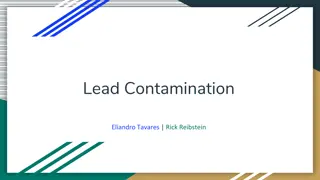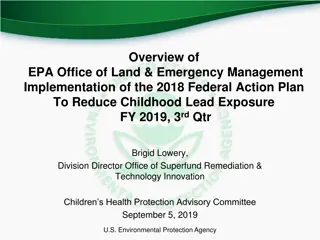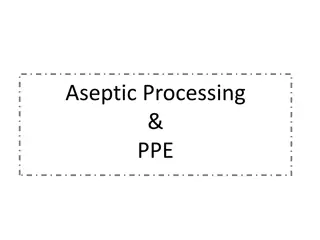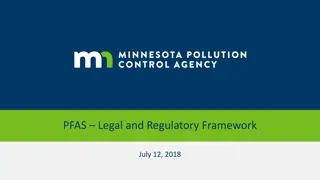Understanding the Economic and Health Impacts of Groundwater Nitrate Contamination in Nebraska
The economic and health costs of groundwater nitrate contamination in Nebraska highlight the challenges of ensuring safe drinking water. Despite largely safe levels, proactive strategies are essential due to rising nitrate levels and costly maintenance efforts. The compliance record shows progress i
0 views • 18 slides
PFAS: State of the Soil Remediation Experts Training
The training session on PFAS (per- and polyfluoroalkyl substances) focuses on the complex family of pollutants, their nomenclature, major categories, and associated risks in various industries. Experts will explore the implications of PFAS contamination and receive recommendations for addressing the
0 views • 20 slides
Understanding Risks and Impacts of Methamphetamine and Fentanyl Contamination
Explore the high risks associated with Methamphetamine and Fentanyl contamination, including the severity and frequency factors. Learn about the environmental exposure routes, consequences for occupants, trends, costs, remediation processes, and more.
0 views • 15 slides
Understanding the Impact of Lead Contamination on Human Health and Ecosystems
Exploring the detrimental effects of lead exposure on human health and the environment, this content touches on lead contamination in drinking water, its effects on various bodily systems, and its impact on ecosystems. It also delves into the history of lead usage, major contributors to lead polluti
0 views • 18 slides
EPA's PFAS Strategic Roadmap: Commitments to Action 2021-2024
EPA's PFAS Strategic Roadmap, initiated by Administrator Michael Regan, outlines key actions from 2021-2024 to safeguard public health and the environment from Per- and Polyfluoroalkyl Substances (PFAS). It includes a comprehensive approach, timelines, and support for state efforts. PFAS are a group
5 views • 13 slides
Understanding Food Microbiology: Sources of Contamination
Humans have broader nutritional requirements than most microorganisms. The human diet includes a wide variety of substances, making our food excellent media for microbial growth. Natural contamination of food by various microorganisms, including pathogens, is common. Food consumed by humans and anim
0 views • 51 slides
Guidelines for Maintaining Hygiene in Manufacturing Environments
The article highlights the importance of hygiene in both manufacturing industries and hospitals, covering key aspects such as manufacturing processes, quality assurance, good manufacturing practices, quality control, and microbial contamination control. Environmental cleanliness and hygiene play a c
0 views • 21 slides
Importance of Meat Hygiene and Sanitation in the Meat Industry
Meat hygiene is essential to ensure the safety and suitability of meat for consumers. It involves implementing specific standards and regulatory actions to maintain cleanliness and prevent contamination at all stages of production. Proper cleaning and sanitization practices, adherence to legal stand
0 views • 16 slides
Microbiological Quality Control in Pharmaceutical Environment
Microbiological products in pharmaceutical settings are influenced by the quality of materials and the environment. Good Manufacturing Practices (GMP) are essential to minimize contamination risks, with control points focused on the ecology of microorganisms. Sources of contamination include the atm
1 views • 128 slides
Safeguarding Your Kitchen: Preventing Cross-Contamination
Cross-contamination poses a risk of foodborne illnesses and can occur in multiple ways, such as using the same utensils for raw and cooked foods. Taking specific cleaning steps at home, like regularly cleaning dish cloths and sanitizing surfaces, is vital to preventing harmful bacteria from spreadin
0 views • 8 slides
EPA's PFAS Action Plan and Drinking Water Activities Update
EPA's PFAS Action Plan, unveiled in February 2019, outlines a comprehensive approach to addressing PFAS challenges nationally. The Agency is committed to regulating PFOA and PFOS and proposes nationwide monitoring for PFAS in drinking water. Additionally, the Technical Support Center (TSC) is active
0 views • 10 slides
Global PFAS Filtration Market
The Global PFAS Filtration Market Size is Anticipated to Exceed USD 3.7 Billion by 2033, Growing at a CAGR of 6.95% from 2023 to 2033.
0 views • 7 slides
Risk-Based Environmental Monitoring for Listeria Surveillance at Retail
Explore the importance of risk-based environmental monitoring and decision-making in detecting Listeria contamination in retail food settings. Learn about routine sampling plans, trends in positive samples, species distribution, and key locations of Listeria findings from 2010 to 2014. Discover why
1 views • 12 slides
Managing Microbiological Quality in Pharmaceutical Environments
The quality of microbiological products is influenced by the pharmaceutical environment materials. Good Manufacturing Practices (GMP) play a crucial role in minimizing contamination risks. Various sources of contamination include the atmosphere, water, persons, raw materials, packaging, buildings, a
0 views • 128 slides
Understanding Pyrogen Testing in Pharmaceutical Production
Pyrogen testing is crucial in ensuring pharmaceutical safety by detecting bacterial toxins that may cause fever in humans. Methods such as the rabbit pyrogen test and human response to pyrogens illustrate the importance of quality control measures in production to prevent contamination. By identifyi
0 views • 8 slides
Contamination Notification Training: Florida Department of Environmental Protection
This document outlines the Contamination Notification Training provided by the Florida Department of Environmental Protection in February 2009. It covers types of contamination notification, governing statutes, rules, and guidance, specific noticing requirements, and changes from prior guidance. The
0 views • 25 slides
Methanol Contamination in Indigenous Fermented Alcoholic Beverages: Impacts and Regulatory Measures
Indigenous fermented alcoholic beverages are facing methanol contamination issues, leading to severe health consequences and fatalities worldwide. This article highlights the concerning incidences of methanol poisoning, symptoms, and regulatory limits in various countries. The informal production of
13 views • 27 slides
Update on Former Wurtsmith Air Force Base State Health Department Community Meeting
The update on former Wurtsmith Air Force Base in Oscoda, Michigan covers discussions with CDC (ATSDR), PFAS in drinking water timeline, key points on PFAS and public health, data evaluation, EPA's health advisory levels, and decision tree for impacted areas. The information emphasizes taking a prote
1 views • 18 slides
Guidelines on EPA Region 9 Response Action Levels for TCE Contamination
EPA Region 9 has established response action levels for TCE contamination, with tiered concentrations for different exposure scenarios. The State of California provides guidance aligned with these levels. DTSC concurs with EPA's residential and industrial response levels but recommends consultation
0 views • 10 slides
Addressing Lead Contamination: Advocating for Effective Legislation
Working towards effective lead contamination legislation involves setting clear goals, engaging with experts and legislators, expanding testing and awareness efforts, and ensuring existing laws are enforced. Key figures like Senators Chang-Diaz and Eldridge are involved, along with advocacy at event
3 views • 6 slides
EPA Office of Land & Emergency Management Overview on Lead Exposure Reduction
EPA's Office of Land & Emergency Management (OLEM) implements various programs to address lead contamination, focusing on reducing childhood lead exposure through cooperative efforts at federal, state, tribal, and local levels. OLEM supports an integrated approach to addressing multiple lead exposur
0 views • 9 slides
Groundwater Contamination Rule Amendments Proposal
Proposed amendments to NCAC 15A.2L.0106 focus on establishing default cleanup requirements for groundwater contamination and providing options for remediation. The amendments aim to clarify compliance boundaries, correct terminology inconsistencies, and enhance rule effectiveness.
0 views • 8 slides
Understanding Aseptic Processing and Contamination Control in Cleanroom Environments
Aseptic processing involves maintaining a sterile environment to prevent contamination in cleanroom settings. The presence of non-viable and viable particulate contamination, such as dust and live microorganisms, poses challenges. Sources of contamination include equipment, structures, surfaces, and
0 views • 29 slides
Overview of PFAS Legal and Regulatory Framework
This document outlines the legal and regulatory framework surrounding PFAS (per- and polyfluoroalkyl substances), including hazardous waste designation, historical context at 3M sites, and the definition of hazardous substances and waste according to Minnesota statutes. It also discusses the potenti
0 views • 19 slides
Understanding Contamination in Research Studies
Understand the concept of contamination in research studies, its impact on the effectiveness of Randomized Controlled Trials (RCTs), and different analysis methods to handle contamination, such as Intention-to-Treat (ITT) and Contamination-Adjusted Intention-to-Treat (CA-ITT) analyses. Learn how to
0 views • 40 slides
Guidelines for Animal Disposal Methods
Environmental and biosecurity guidelines recommend various disposal methods such as composting, rendering, permitted landfill, unlined burial, fixed-facility incineration, and open-air burning. Each method has specific selection criteria and considerations to minimize risks to the environment and bi
0 views • 17 slides
Agricultural Water Safety Regulations Overview
The final Produce Rule and Preventive Controls Rule, effective since November 13, 2015, set criteria for microbial contamination in agricultural water. Generic E. coli levels are key indicators, affecting water uses in post-harvest and production. Criteria like Geometric Mean and Statistical Thresho
0 views • 43 slides
Understanding Contamination OCD: Symptoms, Obsessions, and Misconceptions
Contamination OCD is a subset of OCD characterized by severe fears of becoming contaminated by germs or getting sick. Individuals with this condition may exhibit compulsions such as avoidance, excessive washing, and health testing. It's crucial to differentiate between normal intrusive thoughts and
0 views • 21 slides
Understanding Mental Contamination: Causes and Effects
Mental contamination is a phenomenon where individuals experience feelings of internal dirtiness and distress without physical contact with a contaminant. It is common among women who have experienced sexual trauma. Symptoms include fear of imagined contaminants, ritualistic acts to neutralize them,
0 views • 7 slides
Update on PFAS Method Validation for Non-Drinking Water Samples
Method validation for per- and polyfluorinated alkyl substances (PFAS) in non-drinking water samples was discussed at the ASTSWMO Annual Meeting in October 2017. The focus was on simplicity, robustness, and efficiency in sample processing, with considerations for monitoring requirements. Various met
0 views • 7 slides
Food Safety and Cross-Contamination Prevention Guidelines
Understanding the flow of food is crucial in preventing cross-contamination at various stages of food handling. This chapter delves into key terms, temperature-measuring devices, calibration methods, and guidelines to prevent cross-contamination. By implementing separate equipment, proper cleaning,
0 views • 23 slides
Best Practices for Contamination Control in Pharmaceutical Manufacturing
Implementing a robust Contamination Control Strategy (CCS) as part of the Pharmaceutical Quality System is crucial for ensuring product quality and safety. The strategy encompasses various elements like process risk management, preventative maintenance, and personnel training. Manufacturers must foc
0 views • 19 slides
Understanding PFAS Foam and EPA Regulations for Firefighting Applications
PFAS, components of firefighting foam, pose environmental and health risks due to their persistence. EPA regulations in April 2024 designated PFOA and PFOS as hazardous substances, enforcing controls on PFAS release. Thermal treatment offers a solution for PFAS disposal.
0 views • 6 slides
EPA's PFAS Action Plan: Addressing Potential Health Risks and Environmental Contamination
Per- and polyfluoroalkyl substances (PFAS) pose a significant environmental and health concern due to their widespread use and persistence. EPA's PFAS Action Plan, developed based on extensive feedback and comments, outlines a comprehensive approach to address these challenges. The plan focuses on r
0 views • 15 slides
Exploring Pesticide Monitoring and Contamination Studies in Maine
Mary Tomlinson's work with the Maine Board of Pesticides Control includes past studies on groundwater and surface water monitoring, ongoing monitoring initiatives, and future collaborative studies. The State Law mandates residue surveys to identify possible contamination sources and develop a pestic
1 views • 55 slides
Radiographic Infection Control in Dental Clinics
In dental radiology clinics, infection control is crucial to prevent cross-contamination and disease transmission among patients and staff. Key steps include applying standard precautions, wearing personal protective equipment, disinfecting equipment, and preventing contamination of processing equip
0 views • 16 slides
Petition to Require Health and Environmental Testing for PFAS Manufactured by Chemours in Fayetteville, NC
This petition under the Toxic Substances Control Act urges testing of 54 PFAS linked to Chemours' facility in Fayetteville, NC. It highlights potential health and environmental risks, emphasizing the need for comprehensive testing by an independent panel. Data sources include public utility records,
0 views • 13 slides
Airborne Lead and Arsenic Contamination in Hayden, Arizona Study
Monitoring and analysis of airborne lead and arsenic contamination in Hayden, Arizona revealed significant levels of pollutants stemming from industrial activities. The study site at Hayden High School showed elevated lead deposition fluxes and surface dust contamination, posing potential health haz
0 views • 10 slides
Latest Updates on Wolverine EPA Activities
Explore the latest developments in Wolverine World Wide EPA updates, including personnel changes, PFAS listing, CERCLA PFAS rule updates, and progress at the House Street Disposal Area and Tannery sites. Get insights into upcoming actions like site inspections and rulemaking, shaping the environment
0 views • 14 slides
Clinical Response to PFAS Exposure in the General Population
Exposure to PFAS (per- and polyfluoroalkyl substances) is prevalent among Americans, with pregnant women showing detectable levels. Screening for health effects of exposure includes assessing cholesterol, thyroid function, and other symptoms. There is no known safe level of PFAS exposure, and orderi
0 views • 14 slides







































